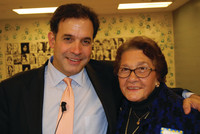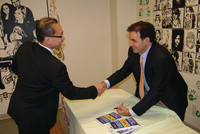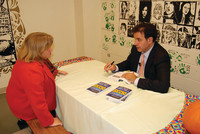Imagine, in the future, being able to determine one’s risk of developing Alzheimer’s disease years in advance, through a simple blood test – and then being prescribed medication that works in …
This item is available in full to subscribers.
We have recently launched a new and improved website. To continue reading, you will need to either log into your subscriber account, or purchase a new subscription.
If you are a current print subscriber, you can set up a free website account by clicking here.
Otherwise, click here to view your options for subscribing.
Please log in to continue |
|




Imagine, in the future, being able to determine one’s risk of developing Alzheimer’s disease years in advance, through a simple blood test – and then being prescribed medication that works in the same way cholesterol-lowering drugs help stave off heart disease.
Dr. Rudolph Tanzi, a native Cranstonian, says recent developments have put that vision within reach. As one of the world’s foremost Alzheimer’s researchers, he had been at the vanguard of critical breakthroughs.
“I guarantee you that by the time we’re done this evening, that you will know as much about Alzheimer’s disease, what causes it, and how we’re going to stop it, as anybody on the planet,” he told an audience last week at Cranston High School East.
“What we’re really going to try to do is stop this disease from ever striking anyone again. By 2025, that’s our goal.”
Tanzi is a 1976 graduate of Cranston East. He serves as director of the Genetics and Aging Research Unit at Massachusetts General Hospital, and as the Joseph P. and Rose F. Kennedy Endowed Chair in Neurology at Harvard Medical School. This year, he was named to TIME magazine’s list of the “100 Most Influential People in the World” and delivered the commencement address at the University of Rhode Island, where he received an honorary doctorate.
Tanzi’s visit to his hometown – and his “Ending Alzheimer’s Disease by 2025” program – was part of the Cranston Senior Enrichment Center’s “55+ Living Better, Living Longer: A Celebration of Fitness for the Body and Mind” initiative, which began several weeks ago with the 20th annual Cranston Senior Games at Cranston High School West.
At the outset of the program, Mayor Allan Fung presented Tanzi with a proclamation and a key to the city.
“He has made our city and our state so proud,” the mayor said. “The work of Dr. Tanzi has made such a meaningful impact, not only for Cranstonians, not only for all Rhode Islanders, but all mankind. That’s something that should be recognized.”
Scores braved the windy, rainy night to watch Tanzi’s presentation, during which he outlined the history of Alzheimer’s research, the symptoms and impacts of the disease, and the role he and his fellow researchers have played in recent, groundbreaking discoveries that have led to unprecedented hope for a way to stop it.
Tanzi recalled performing on the Cranston East stage decades ago with his high school band, Asylum, during a benefit for the Meeting Street School. He noted that several of his former teachers and coaches were in attendance, along with his mother, Ann, and twin sister.
“The last time I was on this stage was almost 40 years ago … I got started loving science here at Cranston East,” he said. “This is a little surreal, to look out and see so many people I know out in the audience while I talk about Alzheimer’s disease.”
Using startling statistics, Tanzi outlined the enormity of Alzheimer’s as a public health issue, calling it the “most disastrous unmet medical need in this country.”
There are 5.3 million victims of the disease in the United States, he said, and a new diagnosis is made roughly once every minute. In 2015, the disease claimed 700,000 lives, affected 15 million caretakers, and cost $226 billion.
Tanzi said worldwide, 40 million people are victims of the disease, and that figure is expected to rise to 100 million by 2040. Women make up two-thirds of Alzheimer’s cases, he said, and “we’re still trying to figure out why that is.”
Tanzi said Alzheimer’s is “really the most common form of dementia in the elderly,” and 40 to 50 percent of all people age 85 and older will develop the disease. He said the pathology in the brain that leads to Alzheimer’s “begins in all of us after 40 years old,” so as life expectancy continues to rise, the incidence of the disease will grow as well.
“When we model Alzheimer’s and do genetics, we don’t ask, ‘Are you going to get the disease?’ but ‘When?’ So that’s kind of scary,” he said.
Tanzi’s description of what Alzheimer’s disease does was also sobering:
“This disease is the worst thing … All your experiences, all the choices you make, lead to interactions in your brain between nerve cells. You have 100 billion nerve cells that are interacting, and form connections called synapses, trillions of them, hundreds of trillions of these connections. So what’s happening is your brain network is forming a tapestry that’s creating who you are your whole life … Alzheimer’s comes in and just rips that tapestry apart, thread by thread. You lose yourself. And those who know you and love you also lose you. There’s nothing worse.”
From there, however, Tanzi pivoted to a message of hope.
“I want to give you good news tonight, that we’re kicking ass,” he said. “Things are going really well.”
Tanzi has been involved in a number of major discoveries during his career, including genes linked to Huntington’s disease, Wilson’s disease and several forms of Alzheimer’s. In the case of Alzheimer’s, he said, a major obstacle for decades had been a debate over the causes of the disease, and the role played by two of its key physical features – known as plaques and tangles, or hard clumps and spaghetti-like coils – in disrupting the normal function of nerve cells in the brain.
Tanzi described the dilemma scientists faced as follows:
“Martians come down from space, and their goal is to understand soccer. And they get to Cranston Stadium, the soccer game was at 4 o’clock, and they get there at 7 o’clock. The game’s over. No one’s even there. And they’re looking around, and they see some turf dug up, some things here … but you have no idea what soccer is. You’re trying to reconstruct it, and the game is already over. You just see the aftermath. That’s where we were for 80 years.”
In the 1980s, while still a student at Harvard, Tanzi discovered the first Alzheimer’s gene. He said that gene and others identified since, all either increase production or inhibit the clearance of a protein fragment, or peptide, which Tanzi dubbed APP, or “amyloid precursor protein.”
“These genes opened the doors,” he said. “Finally, we had some clue about how this was happening in the brain. That broke everything open … [and] changed everything in the field. It was like finding a soccer ball.”
What remained unproven, however, was the precise nature of the relationship between the plaques and tangles. The theory was that APP led to the buildup of plaques and, in turn, the formation of tangles, which essentially choke off nerve cells in the brain and disrupt their ability to communicate.
Tanzi said testing with mice did not demonstrate a direct link between the presence of plaques and the formation of tangles, which led to renewed doubts about the link between the two. An attempt was made to essentially replicate a human brain in a petri dish, growing nerve cells in liquid, but that also proved fruitless.
Then, one of Tanzi’s colleagues, Doo Yeon Kim, made a game-changing observation.
“All the greatest discoveries are simple,” Tanzi recalled. “He said, ‘Dr. Tanzi, the brain isn’t made of liquid’ … This was really his brainstorm, his baby.”
The brain, Tanzi said, is “like three pounds of Jell-O.” So the researchers attempted the petri dish experiment again, this time using a gel rich with brain nutrients.
The results were astounding. The nerve cells created networks like those seen in the brain, communicating with one another. With the introduction of Alzheimer’s genes, plaques developed, followed by tangles and a steep decline in brain activity. The researchers could see the progression of Alzheimer’s as had been theorized.
“Yes, the plaques come first, the plaques cause tangles … By modeling this disease for the first time in a dish, we settled that debate,” Tanzi said. “The pathology is completely stopping these nerve cells from interacting.”
The implications of the discovery have been enormous, bringing what Tanzi described as “clarity of vision” to the field. Testing of Alzheimer’s drugs, he said, can be done “10 times cheaper, 10 times faster” than ever before, and can be easily targeted at any of the mutations linked to the disease. There is renewed interest from the pharmaceutical industry. One drug, he said, is going into clinical trials in humans next year – and it is also effective against the rare, early-onset varieties of Alzheimer’s.
“Now we have hope … that we can stop Alzheimer’s disease even in those people who are doomed to get the disease,” Tanzi said. “Now we can look forward to the right trials, where you’ve got the right drug, the right patient, at the right time … This is a transitional period. I couldn’t have given this talk last year at this time.”
Tanzi said a key piece of the equation is early treatment. He said research has shown drugs meant to stave off increases in APP must be taken early, as soon as there are indications of its buildup or of a genetic predisposition for that to occur. That led him to the comparison with cholesterol and heart disease.
“Amyloid is the cholesterol of Alzheimer’s,” he said.
Also vital, Tanzi said, are several lifestyle factors. In addition to the plaques and tangles, he said inflammation in the brain constitutes one of the three key physical features of Alzheimer’s. He told those present that exercise, a healthy diet, social engagement, and sleep – particularly deep sleep, which he called “mental floss” – are essential in maintaining brain health.
Learning new things is also vital, he said – “Every time you learn something new, you make new synapses … [and] reinforce the synapses you already have” – as is reducing emotional stress through practices such as yoga or meditation. He pointed to an unpublished research paper that found the positive impact of meditation in particular to be “profound.”
Tanzi also spoke of the symptoms of Alzheimer’s, especially in contrast to a “senior moment.”
“It’s OK to forget a name, or a word. That happens to all of us as we get older,” he said. “But if you’re having trouble assembling language, or following a conversation, that’s when there’s a warning sign.”
Tanzi said withdrawal, problems with judgment and mood, and issues comprehending space and time are also signs of Alzheimer’s.
Several dignitaries were in attendance for Tanzi’s presentation, including former mayor and current School Committee member Michael Traficante; former Division of Elderly Affairs director and candidate for lieutenant governor Catherine Taylor; and Rhode Island AARP Director Kathleen Connell.
Tanzi’s list of honors is lengthy. He has received the two highest awards given in the field of Alzheimer’s research, the Metropolitan Life Award and The Potamkin Prize, and he and Kim will soon be honored with a Smithsonian magazine American Ingenuity Award. He also leads the Alzheimer’s Genome Project and the Cure Alzheimer’s Fund Research Consortium.
Other honors include being listed among the “Harvard 100 Most Influential Alumni” by 02138 magazine; being named one of the “Rock Stars of Science” by the Geoffrey Beene Foundation in GQ magazine; and being voted one of the “Most Influential Scientific Minds in the World.”
Tanzi also co-authored “Decoding Darkness: The Search for the Genetic Causes of Alzheimer’s Disease” with Ann B. Parson, and the New York Times bestseller “Super Brain” with Dr. Deepak Chopra. The latter has been produced as a television show for PBS under the same name. He has authored a second book with Chopra, called “Super Genes,” which is being released this month.
Tanzi has additionally been afforded unique opportunities musically. He has performed and recorded with the band Aerosmith, and co-wrote the song “Remember Me” with recording artist Chris Mann.
Proceeds from sales of the song – which Tanzi used to conclude last week’s program – are going to benefit the Cure Alzheimer’s Fund, and more information is available at curealz.org/rememberme.
Comments
No comments on this item Please log in to comment by clicking here